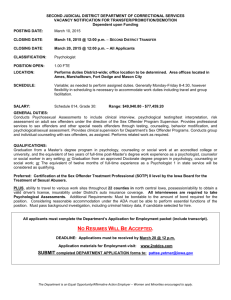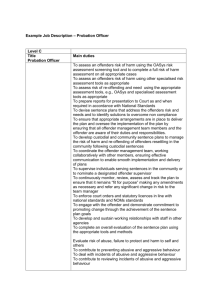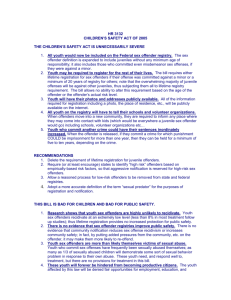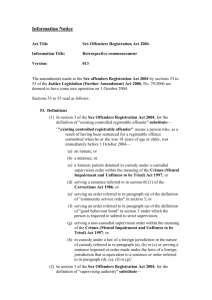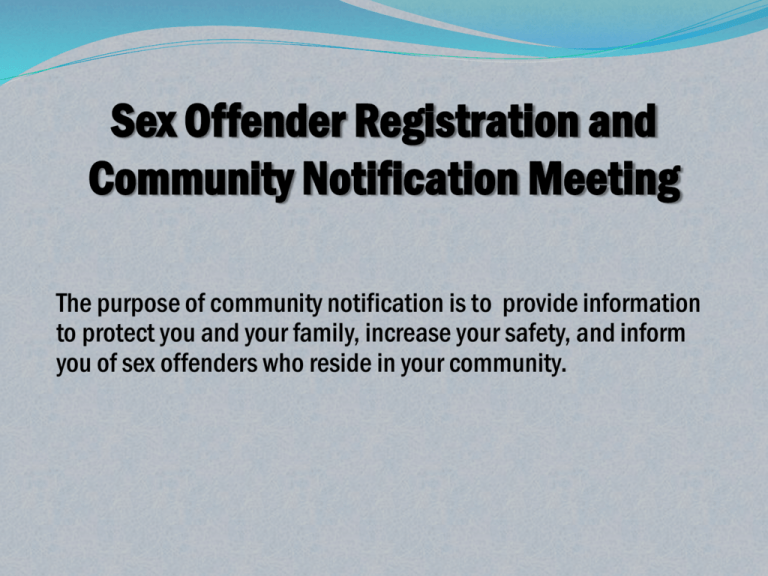
Sex Offender Registration and
Community Notification Meeting
The purpose of community notification is to provide information
to protect you and your family, increase your safety, and inform
you of sex offenders who reside in your community.
Who are the Sex Offenders?
85 to 90% of all sex offenders offend against a family member,
a family friend, or a known acquaintance.
Some sex offenders use their position of authority and/or trust
to gain access to victims i.e. coaches, clergy, or group leaders.
Few offenders offend against strangers.
Why do we need to talk about them?
Most will be released into the community.
Most are not under correctional supervision.
Most can be safely managed in the community.
Communities can help sex offenders stabilize, thereby
reducing recidivism.
Community Safety is Our Concern
Stability of an offender can prevent future
victimization.
Harassment of offenders may increase risk to the
community:
• Offenders may go “underground” so law enforcement
will not be able to monitor them
• Offenders may feel out of control or targeted and reoffend
• Offenders may stop treatment
Community Protection Act of 1990
Became effective February 28, 1990
Offender registration
Community notification
Washington State was the first State in the United States to enact a
Community Notification Law
Notification is one element of the omnibus bill which significantly
changed how sex offenders are maintained in the State
Civil commitment of Sexually Violent Predators
Who has to Register?
Juvenile and adult sex offenders
Convicted of a registrable sex
Currently there are 19,000
registered sex offenders in
Washington State
offense on or after 2/28/90
Less than 20% of registered
Convicted of a certain kidnapping
sex offenders are under
offenses on or after July 1997
community corrections
supervision
Foreign, Tribal, Military and out of
state convictions are required to
Registered sex offender
information is available
register
through your local Sheriff’s
Must register within 3 days of
website and the state website
release or moving to a new
at www.sheriffalerts.com
location
Prior to Release
All registrable sex offender cases are reviewed by the End of
Sentence Review Committee to determine a risk level.
Since 1997, the Committee has been responsible for
establishing the sex offender level of notification. Law
enforcement may depart from the Committee’s Risk Level
Assessment; however, they are required by law to notify the
End of Sentence Review Committee of the departure and
the reasons.
What do the levels mean?
Level I: The majority of registered sex offenders are classified as Level I. They
are considered low risk to re-offend within the community at large. These
persons may be first time offenders and generally have an established
relationship with their victim.
Level II: Moderate risk of re-offend within the community at large. They
generally have more than one victim. These offenders usually groom their
victims. They may use a position of trust to commit their crimes.
Level III: Considered to have a high risk to re-offend in the community at
large. They usually have more than one victim and have committed prior sex
crimes or crimes of violence. They generally do not know their victim(s) or
have a history of grooming victims for the purpose of victimization.
Who is Notified?
Law enforcement is responsible for community notification.
The extent of notification is determined by the offender’s risk level.
Level I: Notification to law enforcement and relevant information upon
request from victims, witnesses and individual community members who
live near the offenders residence. The offender has met some if not all of
the following:
Offense is non-violent
Offense committed in a family setting
Has completed a treatment program
Overall is considered low risk to the community at large
Who is Notified?
Level II: Information posted on the public website and law enforcement may disclose
relevant, necessary, and accurate information to schools, child and family care centers,
businesses and organizations that serve children, women or vulnerable adults, and
individuals and groups near where the offender is regularly found. The offender is
considered to be a moderate risk for reoffending and they meet some or all of the
following:
Offense occurred outside the family setting
Victim is not a blood relative
Offender may not have successfully completed a treatment program
Multiple offenses
Offender poses a risk to the general community
Offender has predatory tendencies in that they involve themselves with families or
communities where there opportunities to seek out and groom victims
Who is Notified?
Level III: The general public will be notified of information on level III sex
offenders. Level III offenders are considered to be a high risk to re-offend in
the community and meet most, if not all of the following:
Offender exhibits predatory tendencies as defined by RCW 71.09.020
Criminal history of repeated sexual offenses, or other acts that include violence
Offender has not a completed treatment program
Sex offenses directed towards strangers and/or the general public
Offender expresses intention and/or desire to continue committing offenses
Offender diagnosed as a sexual predator by mental health professional
Offenses have been directed towards individuals with whom the relationship has been
established or promoted for the primary purpose of victimization
How does notification occur?
Legal notices published in local newspapers for
Level III offenders.
Information on Level II and Level III sex offenders is also
published on the internet. To access, use the link on the
county sheriff’s website or go to www.sheriffalerts.com
The community has a right to know about the offender.
Who is in my community?
Number of offenders registered within the state of Washington.
Number of offenders registered within __________ County.
Level II offenders in __________ County.
Level III offenders in __________ County.
Common Questions?
Can you make them leave? Offenders have the right to live where they choose unless it
violates a condition of their Judgment and Sentence.
How close to schools or child care centers or parks can they live? Washington does not have
residency restrictions unless it is a condition. Residency restrictions are not a protective
factor.
How long do they have to register? It depends on the crime. Minimum for adult offenders is
10 years. It can be lifetime. Juvenile offenders under 15 can petition to be relieved of the
duty to register after two years, older juvenile offenders after five years.
How can I protect my family and myself? Be aware. Talk to you children about personal
safety. Contact your local sexual assault agency for prevention information.
What can I do to protect myself and my family?
Community members should report to law enforcement or the offender’s Community
Corrections Officer, if known, when they see the offender engaging in inappropriate behavior.
Offender Stability is Important to
Community Safety
Compliance with registration obligations +
Compliance with conditions of supervision +
Ongoing treatment as needed and/or required +
Stable place to live +
Support network =
A reduction in the risk that the offender will re-offend.
Address Verification
It is a state law to verify an offender’s address.
• Level I sex offender – once a year
• Level II sex offender – twice a year
• Level III sex offender – quarterly
• Homeless offender – checks in weekly
Offender Specific Information
Questions from the Community?
Community Resources
Community Sexual Assault
Programs
Offender Watch
Talking to your children
information
School counselors
Law enforcement
This Concludes this
Evening’s Presentation
Please share what you have learned tonight with others.
The purpose of these meetings is to empower you by
providing information about sex offenders and about
personal safety.
There are resources in the community to assist you.




